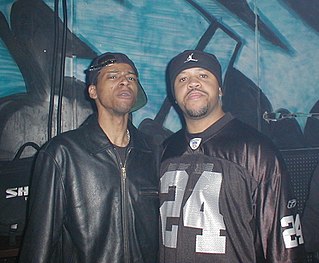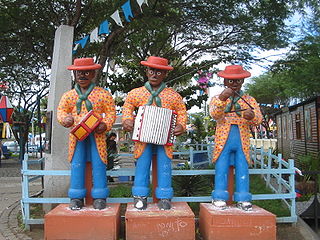House is a genre of electronic dance music characterized by a repetitive four-on-the-floor beat and a typical tempo of 120-130 beats per minute as a re-emergence of 1970's disco. It was created by DJs and music producers from Chicago's underground club culture and evolved slowly in the early/mid 1980s, and as DJs began altering disco songs to give them a more mechanical beat. By early 1988, House became mainstream and supplanted the typical 80s music beat.
Miami bass is a subgenre of hip hop music that became popular in the 1980s and 1990s. The use of drums from the Roland TR-808, sustained kick drum, heavy bass, raised dance tempos, and frequently sexually explicit lyrical content differentiate it from other hip hop subgenres. Music author Richie Unterberger has characterized Miami bass as using rhythms with a "stop-start flavor" and "hissy" cymbals with lyrics that "reflected the language of the streets, particularly Miami's historically black neighborhoods such as Liberty City, Goulds, and Overtown".

Ghettotech is a genre of electronic music originating from Detroit. It combines elements of Chicago's ghetto house with electro, Detroit techno, Miami bass.
Ghetto house or booty house is a subgenre of house music which started being recognized as a distinct style from around 1992 onwards. It features minimal 808 and 909 drum machine-driven tracks and sometimes sexually explicit lyrics.
Kwaito is a music genre that emerged in Soweto, Johannesburg, South Africa, during the 1980s. It is a variant of house music that features the use of African sounds and samples. Kwaito songs occur at a slower tempo range than other styles of house music and often contains catchy melodic and percussive loop samples, deep bass lines, and vocals. Despite its similarities to hip hop music, kwaito has a distinctive manner in which the lyrics are sung, rapped and shouted.
Florida breaks, which may also be referred to as The Orlando Sound, Orlando breaks, or The Breaks, is a genre of breakbeat dance music that originated in the central region of the State of Florida, United States. Florida Breaks originates from a mixture of hip-hop, Miami bass and electro that often includes recognizable sampling of early jazz or funk beats from rare groove or popular film. Florida's breakbeat style feature vocal elements and retains the hip-hop rhythms on which is based. The Florida breakbeat style however is faster, more syncopated, and has a heavier and unrelenting bassline. The beat frequently slows and breaks down complex beat patterns and then rebuilds. The genre has been described as being easy to dance to while creating an uplifting, happy, or positive mood in the listener.

The term forró refers to a musical genre, a rhythm, a dance and the event itself where forró music is played and danced. Forró is an important part of the culture of the Northeastern Region of Brazil. It encompasses various dance types as well as a number of different musical genres. Their music genres and dances have gained widespread popularity in all regions of Brazil, especially during the Brazilian June Festivals. Forró has also become increasingly popular all over the world, with a well-established forró scene in Europe.
Baltimore club, also called B'more club, B'more house or simply B'more, is a music genre that fuses breakbeat and house. It was created in Baltimore, Maryland in the early to late 1990s by 2 Live Crew's Luther Campbell, Frank Ski, and DJ K-Swift, among others.
The coladeira is a music genre from the Cape Verde islands in the central Atlantic Ocean.
Funk carioca, also known as favela funk, in other parts of the world as baile funk and Brazilian funk, or even simply funk, is a hip hop-influenced music genre from Rio de Janeiro, blending the rap subgenres of Miami bass and gangsta rap. Despite its name, funk carioca has no musical correlation with the American funk by any means.

Dance music is music composed specifically to facilitate or accompany dancing. It can be either a whole piece or part of a larger musical arrangement. In terms of performance, the major categories are live dance music and recorded dance music. While there exist attestations of the combination of dance and music in ancient history, the earliest Western dance music that we can still reproduce with a degree of certainty are old-fashioned dances. In the Baroque period, the major dance styles were noble court dances. In the classical music era, the minuet was frequently used as a third movement, although in this context it would not accompany any dancing. The waltz also arose later in the classical era. Both remained part of the romantic music period, which also saw the rise of various other nationalistic dance forms like the barcarolle, mazurka, ecossaise, ballade and polonaise.
Dirty rap is a subgenre of hip hop music that contains lyrical content revolving mainly around sexually explicit subjects.
Polka is a music and dance style that originated in Bohemia in the 1830s and came to American society with immigrants from Europe. A fast style in 2
4 time, and often associated with the pre–World War II era, polka remains a dynamic "niche" music in America.
Footwork, also called juke, footwork/juke or Chicago juke, is a genre of electronic dance music derived from ghetto house with elements of hip hop, first appearing in Chicago in the late 1990s. The music style evolved from the earlier, rapid rhythms of ghetto house, a change pioneered by RP Boo. It may draw from the rapid rhythms and sub-bass frequencies of drum & bass. Tracks also frequently feature heavily syncopated samples from rap, pop and other sources, and are often around 160 bpm.
Electro house is a genre of electronic dance music and a subgenre of house music characterized by heavy bass and a tempo around 125–135 beats per minute. The term has been used to describe the music of many DJ Mag Top 100 DJs, including Benny Benassi, Skrillex, Steve Aoki, and Deadmau5.
Jersey club is a style of electronic club music that originated in Newark, New Jersey in the early 2000s. It was pioneered by DJ Tameil and other members of the Brick Bandits crew, who were inspired by Baltimore club's uptempo hybrid of house and hip hop. Other young producers also pushed for the progression of this style of music in the late 2000s.
Urbano music or Latin urban is a transnational umbrella category including many different genres and styles. As an umbrella term it includes a wide and diverse set of genres and styles such as dancehall, dembow, urban champeta, funk carioca, Latin hip hop and reggaeton. The commercial breakthrough of this music took place in 2017 with artists from Colombia, Cuba, the Dominican Republic, Panama, Puerto Rico, the United States, Venezuela and even non-Spanish-speaking nations, such as Brazil, where Portuguese is spoken.
Bass music is a term used to describe several genres of electronic dance music and hip hop music arising from the 1980s on, focusing on a prominent bass drum and/or bassline sound. As one source notes, there are "many different types of bass music to fall into, each putting a different spin on one of music's loudest elements". Typically, the bass sound is created using synthesizers and drum machines such as the influential Roland TR-808.


